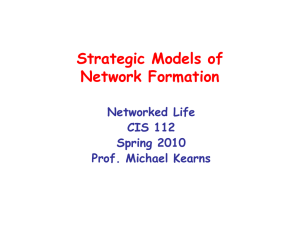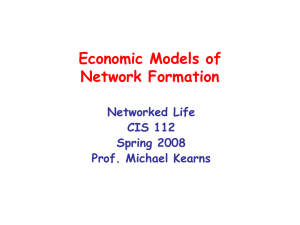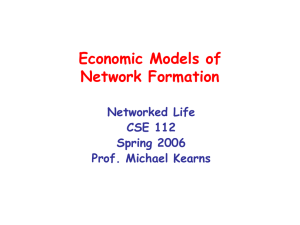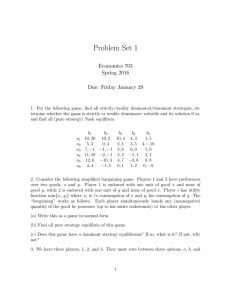Economic Models of Network Formation Networked Life CIS 112
advertisement
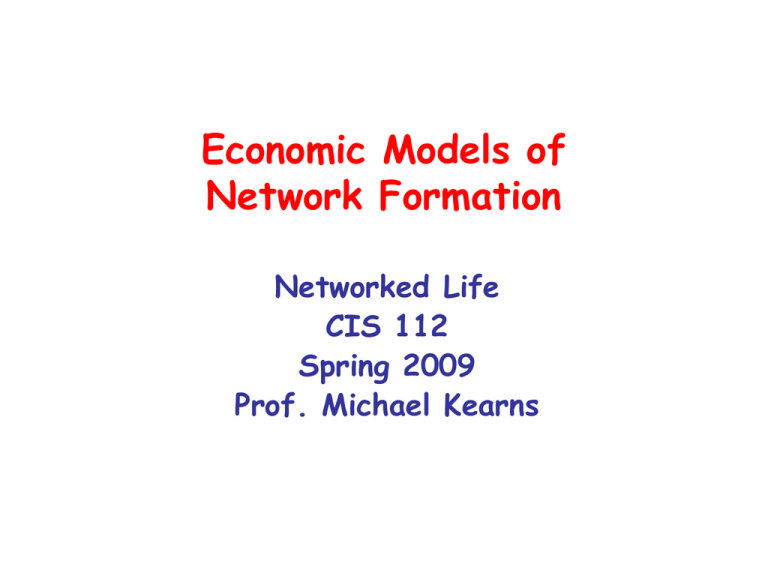
Economic Models of Network Formation Networked Life CIS 112 Spring 2009 Prof. Michael Kearns Background and Motivation • First half of course: – common or “universal” structural properties of “natural” networks • small diameter, high clustering, heavy-tailed degree distributions,… – development of statistical models of network formation • Watt’s “Caveman/Solaria”, alpha model, pref. att., Kleinberg’s model… – analyzed simple “transmission” dynamics • disease/fad spread, forest fires, PageRank,… • Second half of course: – examination of “rational” dynamics in networks • biased voting, exchange economies,… – interaction of rational dynamics with statistical formation models • e.g. when network is formed via pref. att., what will price variation be? • This lecture: let network formation be “rational” as well • A very recent topic Example: A Centrality Game • • • • • • Let’s consider a simply stated network formation game Have N players, consider them vertices in the network Each player has to decide which edges to build or buy Assume a fixed cost c to build an edge Player’s goal: be as “central” in the network as possible Cost to player i: – cost(i) = S j distance(i,j) + c x (# edges bought by i) – distance (i,j) = shortest-path distance between i and j in the network jointly formed by all the players’ edge purchases (infinite if no path) – note: since 1 <= distance(i,j) <= N if NW is connected, sum of distances is between N and N^2, so “interesting” values for c grow with N – players want to minimize their own cost – so need to balance edge costs vs. centrality – (will shortly examine a variant of this cost function) Comments and Clarifications • Formalizing as a one-shot game – contrast with “gradual” or incremental statistical formation models – could imagine multi-round or stage game; more complex • Each player has a huge choice of actions – action for player i: any subset S(i) of all the N-1 edges i could buy – number of choices for S(i) = 2^(N-1) – cost of choosing S(i) = c|S(i)| • Are assuming that if i buys edge to j, j (and all others) can “use” or benefit from this edge (“unilateral” edge formation) • Joint action for all N players: – choice of edge sets for all players: S(1), S(2), …, S(N) • Let G = G(S(1,)S(2),…,S(N)) be the resulting overall graph/NW Nash Networks • Q: How can we view this game a NW formation model? • A: View the NWs generated as being the Nash equilibria • More precisely: say that G can be “formed” by the game if: – G = G(S(1),S(2),…,S(N)) for some choices for the S(i) – S(1),S(2),…,S(N) form a Nash equilibrium of the shortest-paths game – so, no player i can improve cost(i) by unilaterally: • dropping an edge they bought and saving the cost c • adding an edge they didn’t buy and paying the cost c • Look at some examples : star and ring networks, varying c • Contrast: – stochastic formation models (Erdos Renyi, pref. att., etc.) • examine the “likely” structural properties of random networks – game-theoretic formation models • examine the structural properties of equilibrium networks Properties of Equilibria? • Questions we might ask in NW Life: – – – – what are the diameters of the equilibrium graphs? what do their degree distributions look like? what are their clustering coefficients? can we find such games where the equilibria have “desired” properties? • Not much known precisely: • if c > 12Nlog(N) all Nash are trees • if c < sqrt(N/2) some Nash have cycles • We’ll examine two network formation games: – NW formation game based on Kleinberg’s model – NW formation game based on bipartite Milk-Wheat market Kleinberg’s Model • Start with an n by n grid of vertices (so N = n^2) – add some long-distance connections to each vertex: • k additional connections • probability of connection to grid distance d: ~ (1/d)^r – c.f. dollar bill migration paper – so full model given by choice of k and r – large r: heavy bias towards “more local” long-distance connections – small r: approach uniformly random • Kleinberg’s question: – what value of r permits effective navigation? – # hops << N, e.g. log(N) • Assume parties know only: – grid address of target – addresses of their own immediate neighbors • Algorithm: pass message to nbr closest to target in grid An Economic Variation on Kleinberg • Again have N players/vertices, but arrange them in a grid • Grid connections provide free connectivity • Instead of variable probabilities for long-distance edges, introduce variable costs: – – – – let cost to i to purchase edge to j = g(i,j)^a g(i,j) = grid or “Manhattan” distance from i to j a = some constant value so cost grows with distance on grid, at a rate determined by value a – as with Kleinberg, long-distance edges relatively “discouraged” – player’s overall cost function: • edge costs + sum of distances to others (centrality) • So now just have another centrality network formation game • Another striking “tipping point”: – for any a <= 2, all Nash equilibria have constant diameter • i.e. diameter does not grow with N! – for any a > 2, all Nash equilibria have unbounded diameter • i.e. diameter grows (rapidly) with N – Nash equilibria seem to be “regular”, but we don’t know much… What About Navigation? Economic Formation + Economic Dynamics • Recall our simple 2-good exchange economy model: – – – – – – start with a bipartite network between “Milks” and “Wheats” Milks start with 1 unit milk, but value only wheat Wheats start with 1 unit wheat, but value only milk prices = proposed rates of exchange price p means party is willing to exchange their 1 unit for p of other equilibrium prices: prices for each party such that • all parties behave “rationally” = trade only with “best price” neighbor(s) • everyone is able to trade away their initial endowment – at equilibrium, party charging p only trades with parties charging 1/p – equilibrium prices = equilibrium wealths • Before we examined wealth distribution for given networks Price Variation vs. a and n n=1 n = 250, scatter plot n=2 Exponential decrease with a; rapid decrease with n Economic Formation + Economic Dynamics • Now imagine that network is not given, but must be bought/built • Each player i (buyer or seller) chooses a set S(i) of trading partners on the opposing side (sellers or buyers) – – – – – assume each edge costs c to purchase, where c can be paid in milk or wheat edge purchased by one party can be used “for free” by other party once all parties have decided what edges to buy, have some graph G at price equilibrium of G, player i receives wealth W(i) overall payoff to player i: • W(i) – c x (#edges purchased by i) • Can again view this as a network formation model: – possible networks = Nash equilibria of the above game – i.e. a choice of edge sets S(i) bought for each player i such that no party can unilaterally improve their overall payoff by dropping or adding an edge Price Variation? • • • • • • • Can price/wealth variation still be present? How much? What do the equilibrium networks look like? Suppose G = G(S(1),S(2),…,S(N)) is a Nash equil. of this game Let W_min < 1 be smallest wealth (w/o edge costs) Let c be the cost of an edge Then must have W_min > 1 – c This inequality is tight – can construct networks where W_min = 1-c – remember W_avg = 1 • So rational NW formation eradicates inequality… – …up to the cost to buy an edge Network Structure • If G is a Nash equilibrium of this game, then: – G equals its “exchange subgraph” --- no “unused” edges – G consists of (possibly multiple) connected components • each component has uniform prices p, 1/p • Possible equilibrium network structures: • • • • • perfect matching “exploitation” networks: highest wealth variation (high edge costs) “balanced” networks: some, but small, wealth variation strong restrictions on what kind of components can coexist certain exchange rates/wealths are impossible (e.g. 2/5)

